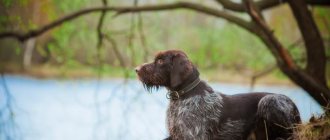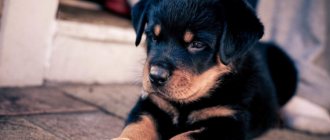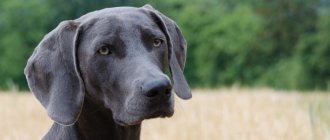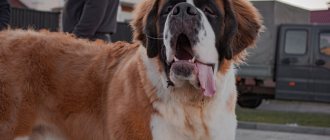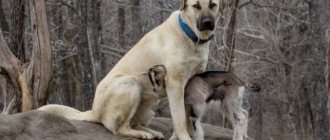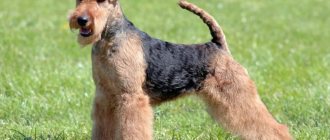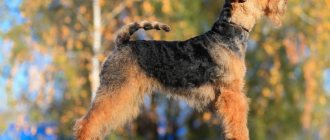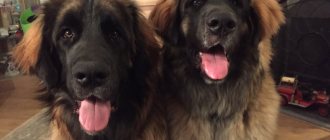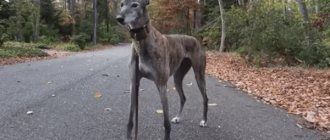Are you a hunter or planning to become one? Do you need a hardy, strong dog, not afraid of bad weather, with excellent sense of smell, capable of hunting in the field, forest, on the water, almost any animal? Take a closer look at the Drathaar breed, or German Wirehaired Pointer.
Thick waterproof coat, noble body contours, lively expression in the eyes, the ability to understand the owner at a glance, universal hunting talents are only part of the advantages of this dog.
If hunting is not part of your plans, the Darthaar will become a good companion for you and your children; he will be happy to “babysit” even kittens - the dog’s calm, balanced character is a real gift, as is its ease of care and good health!
History of the origin of the breed
A large, energetic, slightly high-fronted, harmoniously built, versatile, continental German Wirehaired Pointer, or German Griffon as it is sometimes called, bred in the early 1900s by the German Brotherhood of Hunters, or "Hegewalds" (led by Sigismund Freiherr von Sedlitz and Nijkirch), who prefer upland hunting, from the Poodle Pointer, the Korthals Griffon and the German Stichelhaar (obtained from the big-chested bird hounds - the Barbet and the Shorthaired Pointer) for versatile hunting use for field, forest, water and swamp game, regardless of time of the year.
This is an intelligent, hardy dog, vicious towards the beast, with a faithful and medium-range sense of smell, a firm stance and soft retrieval, although in terms of training and training it is inferior to its short-haired brother.
German Drahthaars (wire-haired pointers) began to be bred at the end of the 19th century in Germany. The breeders set a goal: to obtain an assertive hunting dog with excellent working qualities. The ancestors of the breed are Korthals griffins, Stichelhaars, poodle pointers, shorthaired pointers. In a short time, a new breed was obtained, universal in use and well protected by wool as hard as wire. Drathaars, thanks to their hunting talents, quickly gained popularity both in their native country and throughout the world.
The formation of the breed involved the French Griffon, Pointer Poodle, Shorthaired and Coarse-haired Pointers. Initially, individuals of this breed were used exclusively for hunting, but today they have also proven themselves excellent as domestic companions. The capabilities of drathaars as guards are rather doubtful.
The German Drahthaar breed was bred about a hundred years ago in Germany for versatile hunting purposes: in fields with a stand, in water (apporting game), picking up wounded animals by blood trail, searching for and importing dead game, and even hunting ungulates. German The Drathaar is especially relevant for the Russian climate, because thanks to its hard, tight-fitting coat with a thick short undercoat, the dog is protected from rain, snow, and also from thorny branches.
Puppies: what to look for when choosing?
The issue of purchasing a puppy should be approached very responsibly, since the dog will be next to you for many years. The comfort of living together will largely depend on the right choice of puppy. First of all, you should decide on the purpose of purchasing a pet - it will be a real assistant in hunting game and large animals, or it will become just a friend and companion. In the latter case, it is quite acceptable for puppies to have any deviations from the standard that do not allow them to participate in exhibitions, but are completely invisible to an inexperienced person. Its price will largely depend on the purpose of the dog.
When purchasing a puppy for hunting, it is important to pay attention to its working qualities. Therefore, the choice is best made together with an experienced specialist or on recommendation. Drahthaar puppies must have an RKF metric confirming their hunting origin. It is advisable that parents have awards and diplomas for participating in various hunting competitions. It is necessary to pay attention to the color. Brown-black, graying, and piebald are allowed. Spotted Drahthaar puppies are often found (photos of dogs with different colors can be seen in this article).
The emotional state of the puppy is of no small importance. He must be active, moderately mobile, sociable, and not be afraid of strangers. Inappropriate behavioral reactions may indicate an unstable psyche. It is recommended to purchase a puppy at the age of 3.5 months, when any deviations from the requirements for the breed are already noticeable.
Description of the breed
The current breed standard was approved in 2002. The Drathaar is a versatile hunting dog; they hunt with it in the forest, field, and on the water. Dogs must be able to work on the hunt both before and after the shot. Drathaars have a firm, balanced, manageable character. They should not be timid in front of game, aggressive or cowardly. The height of males is 61-68 cm, females - 57-64 cm. The breed is tested for working qualities.
- The head of the drathaar is proportional to the body of the dog, the muzzle is slightly lowered. The brow ridges and the transition from the forehead to the nose are clearly defined.
- The ears are set wide and high, their size is average.
- The eyes are as dark in color as possible, not protruding, but not too deep set. The expression is energetic and lively. The eyelids are well pigmented and fit tightly.
- The nose of the drathaar is straight, the muzzle is long, massive, wide and deep. A slight hump nose is noticeable. The nose is developed, with wide open nostrils. Pigmentation matches coat color.
- Full regular scissor bite. The teeth are well developed, the jaws are strong. The lips are thick and well pigmented.
- The body has noble outlines, the topline is somewhat sloping, the withers are pronounced, the underline is elegantly curved.
- The chest is deep and wide, the sternum is well developed, the ribs are arched.
- The back of the Drathaar breed is muscular and strong, the loin is wide and short.
- The drathaar's forelimbs are straight, set parallel, the distance from the withers to the elbows is approximately equal to the distance from the elbows to the ground. The paws are round or oval, the toes are gathered into a ball, resting on strong, thick pads with good pigmentation.
- The hind limbs of the drathaar are parallel and straight. The thighs are long, muscular and wide, the lower legs are sinewy. The paws are oval-round in shape, the toes are gathered into a ball. The pads are thick, durable, stable, well pigmented.
- The tail of the drathaar continues the line of the back, the dog holds it horizontally or slightly raised. The vertical position of the tail is unacceptable. The tail is not too thin, but not thick. Can be docked to suit hunting purposes. In countries where docking is prohibited, the Drahthaar's tail should reach the hocks, remaining straight or slightly saber-shaped.
- Drathaar Breed StandardThe Drathaar's coat is hard, wiry, thick and close-fitting. The undercoat does not allow water to pass through, the length of the outer coat is 2-4 cm. The length of the coat should not hide the contours of the body. The stiffness and thickness of the coat protects the dog well from bad weather and minor injuries. The hair on the back of the legs, belly, chest, ears and head is shorter and thicker than on the dog's body. Bearded eyebrows are clearly visible.
- The color of drathaars comes in four types: black with gray hair, with or without spots, brown with gray hair with or without spots, gray hair (otherwise known as grey), brown with a white marking on the chest (or without it).
We advise you to read: American Bulldog Dog Breed
Character of Drathaar
German Drahthaars have an increased need for exercise. They are always on the move, at any moment ready to go for a walk or start a fun romp with their owner.
Active, lively disposition, excellent obedience, natural intelligence, the ability to easily learn new practical skills, exceptional endurance, lack of aggression towards other dogs and strangers, the ability to play well with children.
An excellent hunter, protected from the weather by thick fur, unpretentious in food. Completely non-aggressive towards people. Thanks to its balanced character, it makes an excellent companion.
When planning to get a Drahthaar, remember that this is an active hunting dog. It's better for her not to live in an apartment. Drathaar, if he does not hunt, requires serious physical exertion. In addition, drathaars need communication with the owner, in fairly close contact. These dogs will not be suited to the “feed twice a day, pet and forget” regimen.
If you prefer an active lifestyle and relaxation, then the drathaar will be a wonderful companion for you. Cycling, jogging, long hiking, relaxing by the pond (dogs love to swim) - your pet will love it all! And if in winter you harness the Darthaar to a sled, he will be happy to give your children a ride!
The Drathaar or German Wirehaired Pointer is a very active, intelligent and loyal dog. Dogs of this breed should always be busy; they love it when their owner has a job in which they can help him.
From idleness and lack of exercise, these dogs can easily become bored and uncontrollable. Therefore, it is very important to provide the drathaar with constant exercise or engage in vigorous exercise outside.
Puppies of this breed are very energetic and somewhat irritable. It should be noted that Drahthaar puppies mature late and only become fully mature by the age of 2.
If a Drahthaar is bored or anxious, it will bark excessively or chew on something, which can be a big problem for its owner. Also, the German Wirehaired Pointer often experiences severe separation anxiety from its owner and does not like to be left at home alone for more than a couple of hours. If you work a lot or are often away from home, then this dog breed is not for you.
The Wirehaired German Pointer is not a very easy breed to train. Typically, a Drahthaar puppy requires several months of persistent and consistent training.
Dogs of this breed are very attached to their owner and can be jealous. Early socialization will help to cope with jealousy or minimize its manifestation; it is important to convince the dog that people and their attention do not pose a threat.
Usually these dogs make good guard dogs and not bad protectors.
For families with small children, the German Wirehaired Pointer is not the best choice. However, the drathaar can get along well with older children.
This dog breed has a tendency to be wary of strangers, which can develop into shyness that will be difficult to overcome as an adult.
The Drathaar is a great hunting companion. These are excellent hunters in any terrain. The Drathaar is a dog with a strong sense of smell that searches for prey, points to the location of the game and brings it to its owner. German Wirehaired Pointers are excellent hunting companions both on land and on water. They are hardy, energetic and tireless.
We advise you to read: Dog breeds with blue eyes
Dradhaars are easy to train and are capable of hunting animals and birds. They are unpretentious, easily trained on animals, and usually treat strangers calmly, although sometimes there are very strict dogs. But, as a rule, these dogs are balanced and quite active. Dradhaars have an innate excellent sense of smell and the ability to present prey to the owner; they require almost no special training. All these qualities of the breed have led to the fact that the Dradhaar breed has become very popular among hunters all over the world.
Where to buy and price
The average price of a German Deutsch puppy with documents is 20,000-30,000 rubles. It is better to buy a dog from trusted kennels; the following have a good reputation: Vom Honeverg, Vedgetta, Von der Nebelau.
If you want to have a four-legged friend with a pronounced hunting instinct, the drathaar will be a suitable option. He is not picky in care, maintenance, nutrition, and can adapt to any conditions. High intelligence, endurance, and other positive character traits make him a loyal, intelligent dog.
Caring for Drathaar
The main feature of the breed is its ease of maintenance. No special measures are required; it is enough to periodically brush the dog’s fur. It is not recommended to bathe the drathaar more than twice a year.
Caring for a drathaar is relatively easy. The dog needs to be brushed twice a week and plucked during shedding seasons. The dog's coat should be rough to the touch.
Wash your dog as needed. When bathing, use a special dog shampoo, as human shampoo or liquid soap can irritate the animal's skin.
If your dog is taking part in hunting, it is important to regularly check the dog's ears and the condition of his paw pads.
Like any other dog, the Drahthaar needs regular care for its teeth, eyes and nails.
The Drathaar is a tireless, very energetic dog. Dogs of this breed need a lot of physical activity and mental stimulation.
With a lack of exercise, the drathaar can become restless and annoying.
These dogs are best suited for people who enjoy spending time outdoors and can dedicate ample amount of time to exercise with their dog.
This breed loves to run, swim and fetch. Drathaar feels great if it lives near water.
Feeding
Drahthaar puppies eat the same as other breeds. In the first 3 months of life, the basis of their diet is dairy products. Be sure to add some beef, vegetables, and cereals to them. Food should be warm and semi-liquid - porridge, meat and fish soups with vegetables and cereals. Diet diversity is encouraged. You should not give your puppy fatty, spicy food. Garlic, pepper, and tubular bird bones, which can damage the esophagus, are contraindicated. Puppies at this age need to be fed at least 5 times a day. After he eats, the bowl of food is removed. The dog should have only clean water available at all times.
As the puppy grows, the number of feedings per day is reduced, while the volume of food is increased. So, at six months of age, food is given 3 times a day. And by ten months they are switched to two feedings a day. The Drahthaar puppy should be provided with the vitamins and microelements necessary for growth and proper bone development. For this purpose, fish oil, sodium glycerophosphate, and the drug “Tetravit” are added to food.
What else should you feed your drathaar puppy? Industrially produced dry food is the most practical to use. It is only important that it be of the highest quality, since its health, activity, mood and coat condition largely depend on the diet of a Drahthaar puppy. Premium ready-made dry food contains all the nutrients and vitamins necessary for the full development of the baby. The packaging usually indicates what breeds and ages the product is intended for. Therefore, it is always possible to choose the appropriate option for a particular dog. As a rule, high-quality food cannot be cheap. It is not recommended to immediately buy a large bag. It is better to start by purchasing samples of different varieties to choose the one that your puppy will like the most. Approximately every 3 months, the variety must be changed so that the food does not become boring.
Drathaar's food
Russian traditions of hunting dog breeding prescribe feeding drathaars with natural food (porridge, meat, dairy products). However, many experts believe that drathaars develop no worse when feeding on industrial feed.
The main thing is to follow the general rules for feeding large breeds: feed puppies little and often, adult dogs twice a day, and during periods of intensive growth, give the dog vitamin and mineral supplements.
Accustoming to water
Fearlessness is the main thing you should pay attention to when raising a dog like the Drahthaar. Puppies may not be particularly courageous at first and may experience fear of water, thickets and loud noises. All this can be overcome only through complete understanding and patience on the part of the owner. Rudeness and the use of force are unacceptable.
First, you can sit with the puppy on the shore of a pond. Let him come to the water himself. When he gets older, he needs to be taught to go into a river or lake after his owner. To do this, you need to very gently call the baby. And as soon as he decides to step into the water, immediately praise him and give him a treat. Drahthaar puppies from working parents are rarely afraid of water. It is outweighed by the genetically inherent desire to bring prey.
Training Drathaar
The breed has excellent hunting qualities and excellent training abilities. Drathaars are able to understand their master at a glance. Training these dogs is easy and interesting - they have a balanced character and a flexible psyche. Drathaars very quickly learn to follow all commands given by whistle, gesture or voice.
First of all, you need to teach the puppy to quickly respond to its name. At the first stage, watch how this skill is developed. It is necessary to gradually reduce the number of incentives. Use them only to mark the puppy’s quick and clear reaction to its name. When the puppy begins to respond effectively to the name, begin the second stage. Give encouragement if you notice that the reaction is weakening.
When the puppy is 2 months old, you can begin to carefully, without causing pain, accustom your baby to a leash and harness.
First stage: training to use a harness. It must match the size of the puppy. Be careful when putting on the harness, but act quickly. Let the puppy run freely. Is your baby worried? Start a game, a run. This will distract the dog. Is the puppy behaving well? Praise him, pet him, give him a treat.
At the second stage, the puppy is accustomed to a leash. You need a light leash with a light carabiner, the width of the leash is 1 cm, the length is from 1.5 to 2 m. Your task: attach the leash to the harness and lower it to the floor. Control the situation: the leash should not cling to anything. Start by keeping your puppy on a leash for 20 minutes.
At the third stage, take the leash in your hands to walk with the puppy. Does the puppy pull to the side or stop? Say the nickname, then command “Let's go.” Is the puppy stubborn? Engage him with a treat or toy. For good behavior, “reward” the dog with stroking, praise, and treats.
Remember: the leash cannot be used for punishment so that the puppy is not afraid of it. You should not allow the dog to pull the leash with its teeth or chew it - the leash is not a toy, but a training tool.
The puppy and the external environment: when and how to “get acquainted”
We advise you to read: Cockapoo (Cocker Poodle) dog breed
The main thing is that by this time a strong contact has been established between the dog and the owner. Small puppies are very vulnerable and susceptible if they encounter harsh stimuli. At first you need to protect your dog from them. Choose quiet places for walks, where there are no adult dogs, and walk for a short time. Remember that the puppy has not yet completed the full course of vaccinations, so he must walk in a basket or in your arms.
But the puppy can still be afraid of something. If this happens, switch his attention to the toy and move away from the frightening object. Wait a little and return to the source of fear again. This way the puppy will understand that there is no danger.
The “Come to me” command on a walk
When, while walking, the puppy moves away from you at a distance of 7-8 steps, call him. Did the dog pay attention to you? Command “Come to me.” When your puppy approaches you, praise him, pet him and give him a treat. You need to repeat this exercise about 5 times.
Does your puppy not respond to its name? Repeat it, get attention. Give the command “Come to me” in a louder and more commanding tone. Then show the puppy the treat. Remember that shouting commands and nicknames is prohibited!
Does your puppy continue to ignore commands? Call him, quickly step aside or sit down. This should interest the puppy and he will come to you. Now you can praise him, treat him and pet him.
Command training
Raising a drathaar puppy also involves learning commands. The very first of them are “Come to me”, “You can’t”. And for such a hunting breed it is also “Aport”. After all, one of the purposes of this dog is to bring prey. Under no circumstances should you hit the puppy or shout at it. But be sure to reward with your voice and treats for correct behavior.
The most difficult command to teach a dog is “Fetch”. First you need to interest the animal with a special object (for example, a stick). To do this, it is enough to give the opportunity to grab it, and then try to pick it up, holding the dog by the leash. When she lets go of the stick, spare no praise. You will have to repeat this lesson many times until the baby clearly understands that with the “Fetch” command he is required to bring a certain object. The main thing is not to overwork the puppy with training. The next step will be training to bring game.
Hunting with Drathaar
Drathaars are extremely versatile hunting dogs, giving the statistical hunter (which is an ordinary urban or rural hunter) the opportunity to devote free time to his favorite hobby - hunting with just one gun dog - the Drathaar, and almost during the opening of the hunting season for all available types of game: from the beginning of August to the end of October (in central Russia) - for birds, from October to December - also for animals (hare, fox, wild boar, elk) in accordance with the permitted periods for each species.
In the spring they are used to search for and retrieve downed birds, such as woodcock on the evening draft. Drathaars have a whole range of advantages for hunting. They have hard hair - the thorns that grow both in the field and in the pond do not stick to it; it should be noted that these thorns are simply a scourge for long-haired pointing dogs (for example, setters, spaniels). The type of coat is such that they are not afraid of the cold and do not freeze in cold weather, unlike short-haired pointers (for example, pointers, shorthaired pointers), and with drathaars they hunt in the cold in winter.
Drathaars have a strong backbone, which allows them to work on such support where other breeds of dogs simply cannot physically do this, for example, to search for and feed a pheasant or duck in dense reeds.
Drathaar's Health
The main complaint of the owners of these dogs is related to the occurrence of arthritis in the hip and elbow joints in their pets. It should be noted that thanks to targeted selection, such diseases have recently become much less common. In any case, in order to avoid problems in the future, it is necessary to carefully review the parents' medical records before choosing a puppy.
In general, the breed is in good health, dogs live 12-14 years. However, the breed is prone to arthritis. It is necessary to carefully study the medical records of the parents of your future pet to avoid problems.
The German Wirehaired Pointer is predisposed to the following diseases:
- Hip dysplasia
- Bloating (volvulus)
- Diabetes
- Hypothyroidism
- Otitis
- Lick granuloma
- Pododermatitis (interdigital dermatitis)
- Hot spots (raw eczema)
Also, although less frequently, the following diseases occur in the breeds of this dog:
- Cataract
- Entropion (inversion of the eyelid)
- Progressive retinal atrophy
- Von Willebrand disease
- Mast cell cancer (mastocytoma)
- Rupture of the cranial cruciate ligament (gonarthrosis)
- Melanoma
- Aortic stenosis
